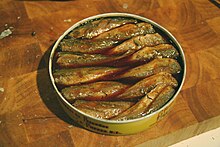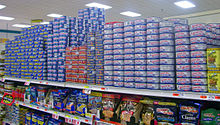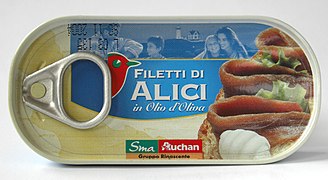Canned fish

Canned or tinned fish are food fish which have been
Fish have low
Preservation techniques are needed to prevent spoilage and lengthen shelf life. They are designed to inhibit the activity of spoilage bacteria and the metabolic changes leading to a loss of quality. Spoilage bacteria are the specific bacteria that produce the unpleasant odours and flavours associated with spoiled fish.[2][3]
Background
The "father of canning" is the Frenchman
Canning was used in the 1830s in Scotland to keep fish fresh until it could be marketed. By the 1840s, salmon was being canned in North America in Maine and New Brunswick.[6] American commercial salmon canneries had their origins in California, and in the northwest of the US, particularly on the Columbia River. They were never significant on the U.S. Atlantic coast. By the 1940s, the principal canneries had shifted to Alaska.[7]
Salmon

A salmon cannery is a factory that commercially cans salmon. It is a fish processing industry that pioneered the practice of canning fish in general. It became established on the Pacific coast of North America during the nineteenth century, and subsequently expanded to other parts of the world that had easy access to salmon.
Prior to canning, fish were salted to preserve them. Through preservation, fish could be transported and sold large distances from where they were caught. At the start of the 19th century, salted salmon caught in Alaska was available in St. Petersburg.[7][8] Shortly after, the Northwest Fur Company started marketing salted salmon from the Columbia River. It then merged with the Hudson's Bay Company, and the salmon was marketed in Australia, China, Hawaii, Japan and the eastern United States. Later, some salmon salteries were converted to salmon canneries.[7]
The first industrial scale salmon cannery in North America was established in 1864 on a barge in the
Sardines
sauce.Canned sardines in supermarkets may actually be
Sardines are typically tightly packed in a small can which is scored for easy opening, either with a pull tab (similar to how a
The close packing of sardines in the can has led to their metaphorical use of the name ("packed like sardines") in describing any situation where people or objects are crowded together, for instance, in a
Tuna

Tunas are often caught far from where they are processed for canning, so poor interim conservation can lead to spoilage. Tuna is typically
The retort cooking process kills any bacteria but retains the
Australian standards once required cans of tuna to contain at least 51% tuna meat, but these regulations were dropped in 2003.
Other fish species
Other fish commonly canned include anchovy, cod, herring, and mackerel.
Gallery
-
Canned anchovies, Italy
-
Canned cod liver, Russia
-
Canned cat food in jelly
-
Children cleaning Atlantic herring at a cannery
-
Carlisle Packaging Company, a floating cod cannery, Yukon River, Alaska, c. 1918
See also
- Cannery Row in Monterey, California
- The novel Cannery Row
- The film Cannery Row
- Fish preservation
- Fish processing
- List of canneries
 Food portal
Food portal
References
- ^ William Schafer (2009-01-09). "Home Canning Tomatoes". Extension.umn.edu. Archived from the original on July 16, 2010. Retrieved 2010-07-14.
- ISBN 92-5-103507-5.
- ^ FAO: Preservation techniques Fisheries and aquaculture department, Rome. Updated 27 May 2005. Retrieved 14 March 2011.
- ISBN 0-415-19399-0.
- ISBN 978-0-313-34745-0.
- ^ Newell, 1990, p. 4.
- ^ a b c Jarvis ND (1988) Curing and Canning of Fishery Products: A History Marine Fisheries Review, 50 (4): 180–185.
- ^ Cobb JN (1917) Pacific salmon fisheries. Government Printing Office, Bur. Fish., Doc 1092. 297 pages.
- ^ a b c Columbia River History: Canneries Northwest Power and Conservation Council. Retrieved 25 December 2022.
- ^ National Park Service Fish and Wildlife Service (August 29, 2018). "First Pacific Coast Salmon Cannery Site".
- ^ a b "Codex standard for canned sardines and sardine-type products codex stan 94 –1981 REV. 1-1995" (PDF). Codex Alimentarius. FAO/WHO Codex Alimentarius Commission. pp. 1–7. Retrieved 2007-01-18.
- ^ "Stinky Sardine Club". Archived from the original on 29 November 2014. Retrieved 25 November 2014.
- ISBN 0-307-38710-0
- ^ Choice: Jan/Feb 2004.
- ^ "The tuna processing industry". US Dept. of Labor. Archived from the original on September 30, 2007. Retrieved 15 October 2007.
- ^ Is canned tuna a good source of omega 3 fats? Archived 2020-02-06 at the Wayback Machine WHFoods. Retrieved 22 September 2012.
- Choice, August 2003.
- ^ "Compare products and find independent product reviews at choice.com.au". Archived from the original on 1 August 2008. Retrieved 25 November 2014.
- ^ "CFR - Code of Federal Regulations Title 21". Accessdata.fda.gov. Retrieved 2010-09-22. (see part (c))
- ^ "FOOD IMPORT GROUP Market Flash: May 2008". Foodimportgroup.blogspot.com. 2008-05-22. Retrieved 2010-09-22.
- ^ "Tuna". Modern Marvels, 4 February 2010.
External links
 Media related to Canned fish at Wikimedia Commons
Media related to Canned fish at Wikimedia Commons









